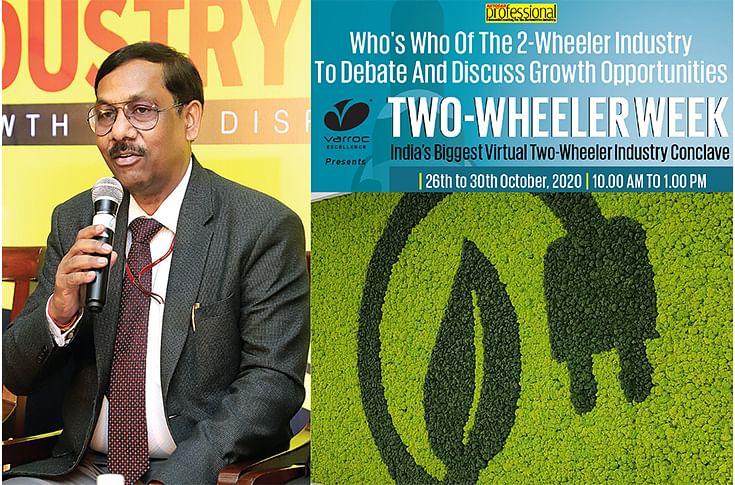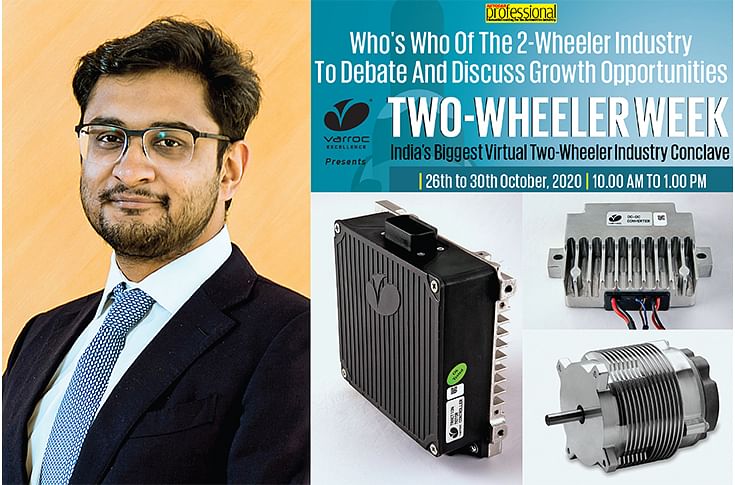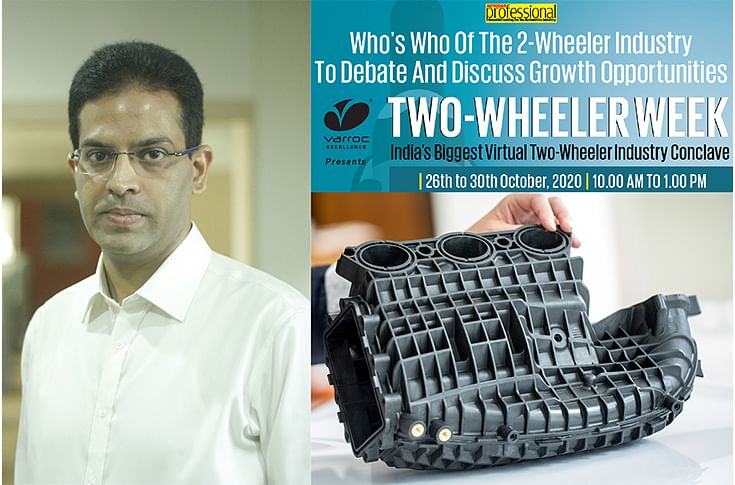Localised EV ecosystem critical to industry growth
The industry stake holders agreed that systematic broadbased localisation can bring about price parity in EVs.
The EV market in India may have had a slow start but it is gaining traction now. The increased need for affordable personal mobility and awareness about sustainable transportation in a Covid-scarred world has offered an additional impetus. Day 3 of the Autocar Professional’s Two-Wheeler Virtual Conclave, focussed on ‘Riding the Electric Mobility Megatrend’. Experts agreed that increased localisation could offer the shortest route to increased EV adoption in the country.
The discussion covered a range of topics including status of the electric mobility industry, key drivers, new opportunities and challenges, technology roadmap development and policies for facilitating the EV industry’s growth. The speakers included –
- Naveen Munjal, MD, Hero Eco Group and President, SMEV
- Anil Srivastava, Principal Adviser, NITI Aayog
- Arjun Jain, Executive Director, Varroc Engineering
- Anand Diwanji, Regional Commercial Director, DSM India
- Mohanraj Ramasamy, founder and CEO, Srivaru Motors
Autocar Professional’s Executive Editor, Sumantra Bibhuti Barooah moderated the session.
Hero Electric’s Naveen Munjal: ‘Localisation has more value when there is more demand’

Hero Electric has been a pioneer in the two-wheeler industry for a long time, even when no other OEM thought of it. It has been a long time since they entered space. However, according to Hero Electric's Managing Director, Naveen Munjal, it is only recently that the segment is seeing momentum, “The traction in the EV market over the past five years is substantial. The business model has changed substantially over the past 2-3 years. Our business model is now subsidy-agnostic. Based on the current eco-system, we believe, at a base case scenario, this market will be two million units over the next five years.”
Munjal said affordability and price parity with existing IC engine two-wheelers is a key driver, “The price-point has also come down to BS VI 100cc vehicle level. Affordability, warranty and convenience are at a place and we hope the timing is right for EVs in India.”
The company has around 12 different products in their line up and use a similar battery system across its platform. This makes it easy for service, usage and various other aspects. Over the last 5-6 years, they have been training the dealer network on what to commit. Munjal pointed out that this has helped gain repeat customers, “Consumers are taking a comprehensive view of the current situation. We are making a practice to train dealers to resist over committing and this has helped in gaining repeat customers.
Around 45% of their customers are repeat customers. “We are building a loyal customer base, addressing them directly and trying to solve their issues. But EV penetration is still low, fragmented and does not have adequate backing by financiers. But we are confident of growth,” Munjal added
Sharing his views on localisation, the MD said, “Localisation has more value when there is more demand. An EV company will depend on a supply chain and for them to deliver efficient products there needs to be a certain volume. The FAME II's intent has been to push larger EV adoption but we need to look at the commercial aspect. In India, with the current volume, localisation will increase the price by 30-35 percent. But, we are working to make localised products. The tier I and II are also serious about EVs and are investing in it. Now, it is important to create demand.”
“India has full opportunity to become a global leader in the electric scooter space in the next few years. We need continuous support from the government and the supply chain. We are thankful to the Delhi and other state governments for their EV friendly policies,” he concluded.
NITI Aayog’s Anil Srivastava: ‘The largest value addition should be from the local products, initiatives and effort’

So what was the policymakers’ perspective on the issue of localisation? Anil Srivastava, Principal Adviser, NITI Aayog- the government think tank on policy initiatives explained that in the current situation, “As far further the government assistance is required, it should be towards localisation, the phased manufacturing program , and international diplomacy. In that scenario, the government and industry should work towards having maximum control over the local supply chain. Atmanirbhar Bharat has to be understood in the right spirit and in terms of globalisation. The largest value addition should be from the local products, initiatives, and effort so that they lead to employment and usage of local resources.”
Naveen Munjal had raised a key concern about the commercial implication of schemes like FAME II, Srivastava agreed to the subsidy-agnostic approach that Hero has adopted and clarified, “The assessment of the FAME II Scheme will be crucial in the latter half of 2021 to take stock of the tweaking it requires and take into consideration if there is a need for an extension. OEMs should try and develop business models independent of subsidies.”
According to Srivastava, lowering of taxes is another key way that government is extending support and pointed out that, “Lowering of GST on EVs to five percent is targeted at making them more affordable. Anomalies in taxation of raw materials, semi-finished products and charging infrastructure needs to be set right. Dynamic duty regime is important, need to act swiftly for the concept of ‘Make In India' to progress adequately.”
Given the growing industry-academia collaboration and plethora of IIT-incubated projects in this space, Srivastava feels this will help bridge the skill gap, “Need to develop skills at the lower level, that has not picked up to satisfying levels, Success of 3-4 month certification programs at lower levels is what we feel is crucial.”
Srivastava acknowledged that, “There has to be consolidation and sharing of technology. The synergy needs to be there for the industry to succeed. It is the need of the industry, it will also be the need of the industry. Be it components, BMS, motors, that will see a lot of players being part of the system.”
Varroc Engineering’s Arjun Jain: ‘Localised capabilities a big advantage’

After an OEM perspective and understanding policy aspects, the next stop was at the component level. Arjun Jain, Business head – Electrical & Electronics Division, Varroc Engineering reaffirmed the company’s vision to leverage localisation, “Localised supply chain with early mover advantage gives Varroc the ability to drive scale and capabilities. “
The two-wheeler industry operates at a significant scale. Backing from supply chain, manufacturing capability to service the requirements of EVs in India as per Jain, “We have been working on the motor and controller for EVs since 2016; we have an early mover advantage for it and can develop solutions with our partners and OEMs. In terms of M&A, we look at potential partners that can complement our capabilities, instead of just bringing core capabilities. At Varroc, we believe that we can develop technologies to supply for the IC- and electric two-wheeler industry that operates at scale and breath-taking speed. The OEMs cannot simply depend on a company that is many miles away.”
Jain pointed out an inherent advantage for Indian component players globally, given that Indians (OEMs) are the biggest players (in terms of volume), “so being an Indian supplier is an inherent strength. The Indian two-wheeler industry sells around 20 million vehicles annually, it is not easy to scale up and compete with Indian players easily. We view localisation to be mission-critical to bring cost-efficiency. In the two-wheeler space, we are already very cost-competitive.”
Jain highlighted that, “Most component makers directing technology push towards a range of EVs that is at par with the available IC-engine products, looking for creating cost competitive offerings in this range.”
Bringing in a touch of positivity and elucidating the role of a component supplier, Jain explained, “Varroc is looking to make sure that they are building proprietary solutions, clear with customers about the role Varroc is playing in the development of products/components. Depends on the customer needs but Varroc is prepared to cater to every type of customer needs. “
DSM India’s Anand Diwanji: ‘Localisation is key aspect to pay attention’

Lightweighting is an important consideration for enhancing the EV’s efficiency. Anand Diwanji, Regional Commercial Director, DSM India pointed out that the value chain here is mature enough and the timing to localise the EV products is important, “Automotive industry in India amongst the most cost competitive segments globally. Volume- price ratio a crucial consideration. Localisation is key aspect to pay attention.”
“EV can play a major role here and the term sustainability is also important. But, other than the light-weighting, thermal management and various other aspects plays a crucial role in an EV. There are a lot of India specific requirements that come into play," he added.
Quality is another key aspect when we talk about effective localisation. Dewanji highlighted that, "Therefore, it is very imperative that the right materials are used. The value chain has to start thinking about using sustainable, bio-based materials that reduce carbon footprint. The timing of localisation is crucial as India is among the world big manufacturing hubs. Rapid changes are underway in the environment. Regulation, customer behaviour play a key role in this. Overall, there is a need to keep the cost under control."
Srivaru Motors’ Mohan Ramasamy: ‘Localised production of controller to play a key role to enhance affordability of the product’

Srivaru Motors, a new player in the EV space further broke down the localisation conundrum to specific parts that need attention for effective localisation of products, “Lot of elements in EVs still not localised in India, to keep it sustainable India needs to develop local capabilities for building controllers.”
According to him, “Technology to bring down battery cost and localised production of controller to play a key role to enhance affordability of the product.”
He is optimistic about India climbing up the value chain in the electric two-wheeler space globally, “Indians have the ability to adapt to any opportunity very well and aspire and work towards achieving leadership position, situation no different in EV space. Alliance between start-up and matured companies crucial to help gain momentum in market.”
The industry stake holders agreed that systematic broadbased localisation can bring about price parity in EVs. According to them affordability coupled with adequate convenience will push the EV momentum in India.
RELATED ARTICLES
JSW MG Motor India confident of selling 1,000 M9 electric MPVs in first year
The 5.2-metre-long, seven-seater luxury electric MPV, which will be locally assembled at the Halol plant in Gujarat, wil...
Modern Automotives targets 25% CAGR in forged components by FY2031, diversifies into e-3Ws
The Tier-1 component supplier of forged components such as connecting rods, crankshafts, tie-rods, and fork bridges to l...
VinFast’s second plant in Vietnam goes on stream ahead of India factory
Vietnamese EV maker’s second plant in its home market, which has a 200,000 EVs-per-annum capacity, will focus on produci...





 28 Oct 2020
28 Oct 2020
 6880 Views
6880 Views





 Autocar Professional Bureau
Autocar Professional Bureau




